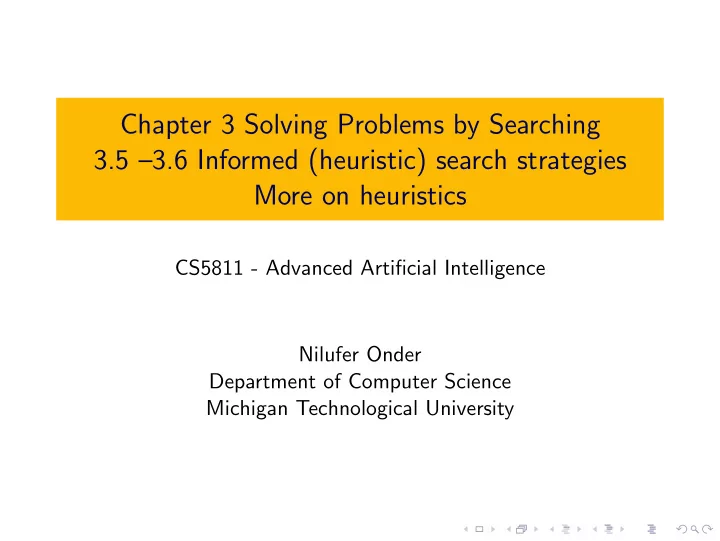

Chapter 3 Solving Problems by Searching 3.5 –3.6 Informed (heuristic) search strategies More on heuristics CS5811 - Advanced Artificial Intelligence Nilufer Onder Department of Computer Science Michigan Technological University
A ∗ search We have seen that A ∗ search ◮ May have exponential time and space complexity but will perform well with a good heuristic ◮ Is complete ◮ Finds the optimal solution We will look at another property that affects how the search proceeds.
Consistency A heuristic is consistent if h ( n ) ≤ c ( n , a , n ′ ) + h ( n ′ ) If h is consistent, we have n f ( n ′ ) = g(n’) + h(n’) = g(n) + c(n,a,n’) + h(n’) c(n, a, n’) g(n) + h(n) h(n) ≥ = f(n) n’ We get f ( n ′ ) ≥ f ( n ), i.e., G f ( n ) is nondecreasing along any path. h(n’) Consistency is the triangle inequality for heuristics.
Progress of A ∗ with an inconsistent heuristic I g=0, h=6, f=6 2 2 g=2, h=2, f=4 g=2, h=5, f=7 1 2 g=4, h=1, f=5 g=3, h=1, f=4 4 g=7, h=0, f=7 g=8, h=0, f=8 G Note that h is admissible. It never overestimates.
Progress of A ∗ with an inconsistent heuristic I g=0, h=6, f=6 2 2 g=2, h=2, f=4 g=2, h=5, f=7 1 2 g=4, h=1, f=5 g=3, h=1, f=4 4 g=7, h=0, f=7 g=8, h=0, f=8 G The root node was expanded. Note that f decreased from 6 to 4.
Progress of A ∗ with an inconsistent heuristic I g=0, h=6, f=6 2 2 g=2, h=2, f=4 g=2, h=5, f=7 1 2 g=4, h=1, f=5 g=3, h=1, f=4 4 g=7, h=0, f=7 g=8, h=0, f=8 G The suboptimal path is being pursued. The right hand side path is suboptimal.
Progress of A ∗ with an inconsistent heuristic I g=0, h=6, f=6 2 2 g=2, h=2, f=4 g=2, h=5, f=7 1 2 g=4, h=1, f=5 g=3, h=1, f=4 4 g=7, h=0, f=7 g=8, h=0, f=8 G Goal found, but it appears as a child now. Remember that we cannot goal-test a node until it is selected for expansion.
Progress of A ∗ with an inconsistent heuristic I g=0, h=6, f=6 2 2 g=2, h=2, f=4 g=2, h=5, f=7 1 2 g=4, h=1, f=5 g=3, h=1, f=4 4 g=7, h=0, f=7 g=8, h=0, f=8 G The node with f = 7 is selected for expansion. After expansion, the lower node of the diamond gets a new, lower cost.
Progress of A ∗ with an inconsistent heuristic I g=0, h=6, f=6 2 2 g=2, h=2, f=4 g=2, h=5, f=7 1 2 g=4, h=1, f=5 g=3, h=1, f=4 4 g=7, h=0, f=7 g=8, h=0, f=8 G The optimal path to the goal is found. But nodes had to be reopened.
Iterative deepening A* (IDA*) search ◮ Idea: perform iterations of DFS. The cutoff is defined based on the f -cost rather than the depth of a node. ◮ Each iteration expands all nodes inside the contour for the current f -cost, peeping over the contour to find out where the contour lies.
The progress of IDA* Arad h=366 140 75 118 Sibiu h=253 f=393 Timisoara Zerind f=118+329=447 f=75+374=449 140 80 151 99 Arad Fagaras Oradea Rimnicu V. f=413 f=415 f=280+366=646 f=291+380=671 Sibiu Bucharest Craiova Pitesti Sibiu f=417 f=338+253=591 f=450+0=450 f=366+160=526 f=300+253=553 f−limits: 366 (Arad), 393 (Sibiu), 413 (RV), 417 (Pitesti) Bucharest Craiova Rimnicu V. 418 (Bucharest, goal) f=418+0=418 f=455+160=615 f=414+193=607 The blue nodes are the ones A* expanded. For IDA ∗ , they define the new f-limit.
IDA* algorithm function IDA* ( problem ) returns a solution sequence (or failure) initialize the frontier using the initial state of problem f-limit ← f-cost( root ) // f-limit: current f-cost limit loop do solution , f-limit ← DFS-Contour ( root , f-limit ) if solution is non-null then return solution if f-limit = ∞ then return failure
IDA* algorithm (cont’d) function DFS-Contour ( node, f-limit ) returns a solution sequence (or failure) and a new f-cost limit // next-f is initialized to ∞ if node .f-cost > f-limit then return null, node .f-cost if the node contains a goal state then return node, f-limit for each child n in node . Child-Nodes do solution, new-f ← DFS-Contour ( n, f-limit ) if solution is not null then return solution, f-limit next-f ← Min ( next-f,new-f ) return null, next-f
F-contours for A* search O N Z I A S 380 F V 400 T R P L H M U B 420 D E C G
Properties of IDA* ◮ Complete: Yes, similar to A*. ◮ Time: Depends strongly on the number of different values that the heuristic value can take on. 8-puzzle: few values, good performance TSP: the heuristic value is different for every state. Each contour only includes one more state than the previous contour. If A* expands N nodes, IDA* expands 1 + 2 + . . . + N = O ( N 2 ) nodes. ◮ Space: It is DFS, it only requires space proportional to the longest path it explores. If δ is the smallest operator cost, and f ∗ is the optimal solution cost, then IDA* will require b × f ∗ /δ nodes to be stored. ◮ Optimal: Yes, similar to A*
Summary ◮ Consistency enforces the triangle inequality ◮ If an admissible but not consistent heuristic is used for graph search, we need to adjust path costs when a node is rediscovered ◮ Heuristic search usually brings dramatic improvement over uninformed search ◮ Keep in mind that the f-contours might still contain an exponential number of nodes
Recommend
More recommend